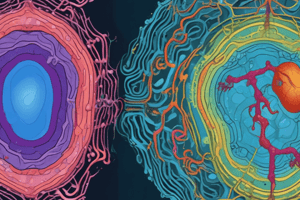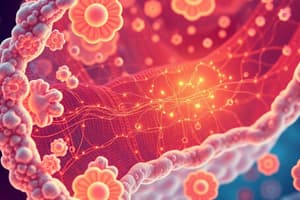Podcast
Questions and Answers
What is the structure of the human cell membrane?
What is the structure of the human cell membrane?
The human cell membrane is made of a phospholipid bilayer.
Define membrane permeability.
Define membrane permeability.
Membrane permeability is the ease with which substances can pass through the cell membrane.
What are the types of membrane channels?
What are the types of membrane channels?
- Leak channels
- Voltage-gated channels
- Ligand-gated channels
- All of the above (correct)
What is passive transport?
What is passive transport?
Simple diffusion transports substances from areas of high concentration to areas of ______.
Simple diffusion transports substances from areas of high concentration to areas of ______.
Match the types of membrane transport with their characteristics:
Match the types of membrane transport with their characteristics:
What influences the rate of simple diffusion?
What influences the rate of simple diffusion?
Which substances can pass directly through the lipid bilayer?
Which substances can pass directly through the lipid bilayer?
What is the structure of the human cell membrane?
What is the structure of the human cell membrane?
The cell membrane is freely permeable to all substances.
The cell membrane is freely permeable to all substances.
Define membrane permeability.
Define membrane permeability.
Which of the following is NOT a type of membrane transport?
Which of the following is NOT a type of membrane transport?
The cell membrane is freely permeable to all substances.
The cell membrane is freely permeable to all substances.
What type of channels open by changes in electrical charge?
What type of channels open by changes in electrical charge?
What does osmosis refer to?
What does osmosis refer to?
Transport that does not require energy is known as ______ transport.
Transport that does not require energy is known as ______ transport.
What role do integral proteins play in the cell membrane?
What role do integral proteins play in the cell membrane?
Match the types of membrane transport to their characteristics:
Match the types of membrane transport to their characteristics:
Which substances can pass directly through the lipid bilayer?
Which substances can pass directly through the lipid bilayer?
What is the effect of the concentration difference on diffusion rate?
What is the effect of the concentration difference on diffusion rate?
Flashcards are hidden until you start studying
Study Notes
Structure of the Cell Membrane
- Composed of a phospholipid bilayer featuring hydrophilic heads and hydrophobic tails.
- Hydrophilic heads orient toward the aqueous environment, while hydrophobic tails face inward, creating a barrier that restricts water and water-soluble ions' passage.
- Integral proteins span the membrane, contributing to structural integrity and facilitating transport.
Membrane Protein Functions
- Channel Proteins: Provide pathways for the diffusion of water-soluble substances, such as glucose and electrolytes.
- Carrier Proteins: Assist in the transport of specific molecules across the membrane.
- Receptor Proteins: Serve as binding sites for hormones and neurotransmitters, facilitating cellular communication.
- Enzymatic Proteins: Catalyze chemical reactions that occur at the membrane surface.
Membrane Transport Definitions
- Cell-membrane transport: Mechanisms regulating the passage of solutes and molecules across the membrane.
- Permeability: Indicates how easily substances pass through the membrane; characterized as impermeable, freely permeable, or selectively permeable.
Types of Membrane Channels
- Leak Channels (Pores): Continuously open, allowing substances to pass freely.
- Voltage-gated Channels: Open in response to changes in membrane potential.
- Ligand-gated Channels: Activated by binding to specific molecules, such as neurotransmitters.
Mechanisms of Transport
- Directly through Lipid Bilayer: Fat-soluble substances (e.g., O2, CO2) diffuse through the bilayer directly.
- Through Protein Channels: Water-soluble substances (e.g., glucose, iron) utilize protein channels for transport.
Types of Membrane Transport
-
Passive Transport:
- Simple Diffusion: Movement along the concentration gradient without energy expenditure.
- Facilitated Diffusion: Involves carrier proteins to assist diffusion.
- Osmosis: Diffusion of water across a selectively permeable membrane.
-
Active Transport:
- Primary Active Transport: Directly uses ATP to move substances against their concentration gradient.
- Secondary Active Transport: Relies on the energy from primary transport to move additional substances.
- Vesicular Transport: Includes exocytosis and endocytosis for transporting large volumes or particles.
Factors Influencing Simple Diffusion
- Concentration Gradient: Greater differences in concentration between two sides of the membrane increase the diffusion rate.
- Molecular Size: Smaller molecules diffuse more easily than larger ones.
- Number of Open Channels: More available channels enhance the diffusion rate, such as sodium channels activated by acetylcholine at neuromuscular junctions.
Structure of the Cell Membrane
- Composed of a phospholipid bilayer featuring hydrophilic heads and hydrophobic tails.
- Hydrophilic heads orient toward the aqueous environment, while hydrophobic tails face inward, creating a barrier that restricts water and water-soluble ions' passage.
- Integral proteins span the membrane, contributing to structural integrity and facilitating transport.
Membrane Protein Functions
- Channel Proteins: Provide pathways for the diffusion of water-soluble substances, such as glucose and electrolytes.
- Carrier Proteins: Assist in the transport of specific molecules across the membrane.
- Receptor Proteins: Serve as binding sites for hormones and neurotransmitters, facilitating cellular communication.
- Enzymatic Proteins: Catalyze chemical reactions that occur at the membrane surface.
Membrane Transport Definitions
- Cell-membrane transport: Mechanisms regulating the passage of solutes and molecules across the membrane.
- Permeability: Indicates how easily substances pass through the membrane; characterized as impermeable, freely permeable, or selectively permeable.
Types of Membrane Channels
- Leak Channels (Pores): Continuously open, allowing substances to pass freely.
- Voltage-gated Channels: Open in response to changes in membrane potential.
- Ligand-gated Channels: Activated by binding to specific molecules, such as neurotransmitters.
Mechanisms of Transport
- Directly through Lipid Bilayer: Fat-soluble substances (e.g., O2, CO2) diffuse through the bilayer directly.
- Through Protein Channels: Water-soluble substances (e.g., glucose, iron) utilize protein channels for transport.
Types of Membrane Transport
-
Passive Transport:
- Simple Diffusion: Movement along the concentration gradient without energy expenditure.
- Facilitated Diffusion: Involves carrier proteins to assist diffusion.
- Osmosis: Diffusion of water across a selectively permeable membrane.
-
Active Transport:
- Primary Active Transport: Directly uses ATP to move substances against their concentration gradient.
- Secondary Active Transport: Relies on the energy from primary transport to move additional substances.
- Vesicular Transport: Includes exocytosis and endocytosis for transporting large volumes or particles.
Factors Influencing Simple Diffusion
- Concentration Gradient: Greater differences in concentration between two sides of the membrane increase the diffusion rate.
- Molecular Size: Smaller molecules diffuse more easily than larger ones.
- Number of Open Channels: More available channels enhance the diffusion rate, such as sodium channels activated by acetylcholine at neuromuscular junctions.
Studying That Suits You
Use AI to generate personalized quizzes and flashcards to suit your learning preferences.



